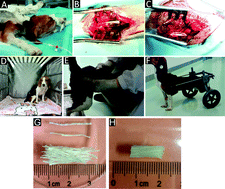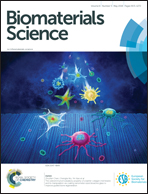Taxol-modified collagen scaffold implantation promotes functional recovery after long-distance spinal cord complete transection in canines†
Abstract
Treatment of spinal cord injury (SCI) remains a clinical challenge worldwide because of the complicated inhibitory microenvironment formed post-injury, reduced axonal regenerative ability of spinal cord neurons, and scarcity of endogenous neurogenesis within the lesion center. Taxol, in addition to stabilizing microtubules, has shown potential for decreasing axonal degeneration and reducing scar formation after SCI in rodents. In this study, we further verified the therapeutic effects and clinical potential of Taxol on restriction of scar formation and promotion of neuronal regeneration and functional recovery after severe spinal cord transection in a large animal (canine) model. A linear-ordered collagen scaffold (LOCS) combined with Taxol was implanted into the injury site after the complete removal of 1 cm of spinal tissue. Afterwards, diligent nursing and multi-system rehabilitation were carried out during a half-year period of observation. The results showed that LOCS + Taxol implantation markedly promoted motor-evoked potentials and locomotion recovery. Moreover, histological analysis demonstrated that LOCS + Taxol implantation significantly increased neurogenesis and axon regeneration to reconnect the spinal cord stumps. Additionally, reduced glial scar formation was observed within the lesion site. Thus, LOCS + Taxol implantation treatment is a promising combinatorial therapy for the treatment of acute long-distance spinal cord defects.



 Please wait while we load your content...
Please wait while we load your content...